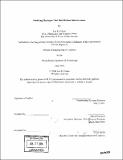| dc.contributor.advisor | Jarrod Goentzel. | en_US |
| dc.contributor.author | Pulido, Jon R. (Jon Ramon), 1974- | en_US |
| dc.contributor.other | Massachusetts Institute of Technology. Engineering Systems Division. | en_US |
| dc.date.accessioned | 2005-11-03T16:52:46Z | |
| dc.date.available | 2005-11-03T16:52:46Z | |
| dc.date.copyright | 2004 | en_US |
| dc.date.issued | 2004 | en_US |
| dc.identifier.uri | http://hdl.handle.net/1721.1/29529 | |
| dc.description | Thesis (M. Eng. in Logistics)--Massachusetts Institute of Technology, Engineering Systems Division, 2004. | en_US |
| dc.description | Includes bibliographical references (p. 70-73). | en_US |
| dc.description.abstract | This thesis' fundamental research question is to evaluate the structure of the hydrogen production, distribution, and dispensing infrastructure under various scenarios and to discover if any trends become apparent after sensitivity analysis. After reviewing the literature regarding the production, distribution, and dispensing of hydrogen fuel, a hybrid product pathway and network flow model is created and solved. In the literature review, an extensive analysis is performed of the forthcoming findings of the National Academy of Engineering Board on Energy and Environmental Systems (BEES). Additional considerations from operations research literature and general supply chain theory are applied to the problem under consideration. The second section develops a general model for understanding hydrogen production, distribution, and dispensing systems based on the findings of the BEES committee. The second chapter also frames the analysis that the thesis will review using the model. In the problem formulation chapter, the details of the analytic model at examined at length and heuristics solution methods are proposed. Three heuristic methodologies are described and implemented. An in-depth discussion of the final model solution method is described. In the fourth chapter, the model uses the state of California as a test case for hydrogen consumption in order to generate preliminary results for the model The results of the MIP solutions for certain market penetration scenarios and the heuristic solutions for each scenario are shown and sensitivity analysis is performed. The final chapter summarizes the results of the model, compares the performance of heuristics, and indicates further areas for research, both in terms of developing strong lower bounds | en_US |
| dc.description.abstract | (cont.) for the heuristics, better optimization techniques, and expanded models for consideration. | en_US |
| dc.description.statementofresponsibility | by Jon R. Pulido. | en_US |
| dc.format.extent | 236 p. | en_US |
| dc.format.extent | 16292968 bytes | |
| dc.format.extent | 16323757 bytes | |
| dc.format.mimetype | application/pdf | |
| dc.format.mimetype | application/pdf | |
| dc.language.iso | eng | en_US |
| dc.publisher | Massachusetts Institute of Technology | en_US |
| dc.rights | M.I.T. theses are protected by copyright. They may be viewed from this source for any purpose, but reproduction or distribution in any format is prohibited without written permission. See provided URL for inquiries about permission. | en_US |
| dc.rights.uri | http://dspace.mit.edu/handle/1721.1/7582 | |
| dc.subject | Engineering Systems Division. | en_US |
| dc.title | Modeling hydrogen fuel distribution infrastructure | en_US |
| dc.type | Thesis | en_US |
| dc.description.degree | M.Eng.in Logistics | en_US |
| dc.contributor.department | Massachusetts Institute of Technology. Engineering Systems Division | |
| dc.identifier.oclc | 57350029 | en_US |
